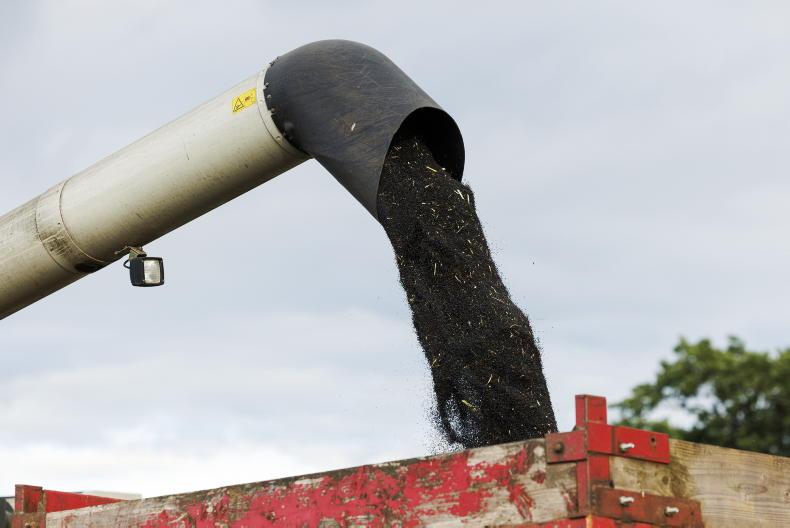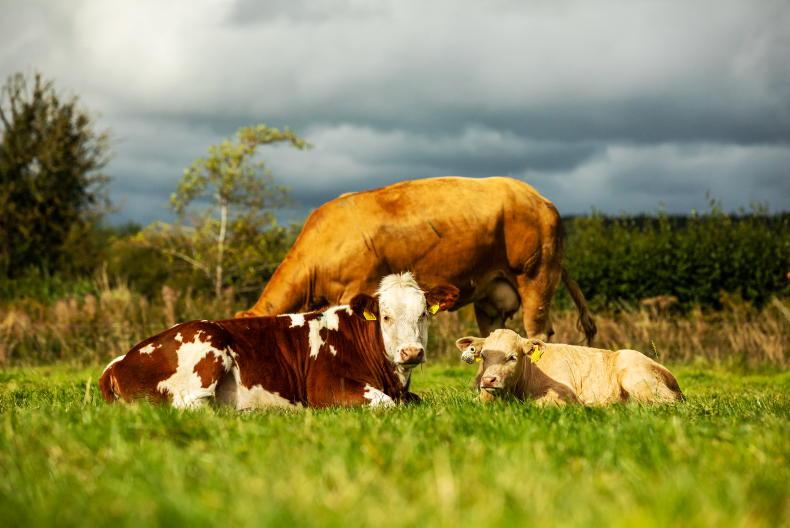Irish fertiliser supply chain profits soared in 2022 as the price of the product more than doubled in the wake of the Russian invasion of Ukraine. Analysis of financial results shows that companies generally held their percentage gross margins unchanged, as prices rapidly rose in the period.
In practice, this means that when the cost of importing fertiliser soared, the end purchaser of the product had to bear the extra cost of both the increased input cost and the much larger euro-value of the importer’s margin.
Of the companies which have reported results for 2022 and which exclusively sell into the Irish market, we see a very similar pattern. Total revenue from sales doubled, as did the cost of raw materials.
Combining the companies, Grassland Kilkenny, Target and Nitrofert, which between them accounted for approximately 40% of Irish fertiliser sales, we see revenue increase from €201m in 2021 to €431m in 2022.
The cost of fertiliser increased from €180m to €390m, leading to an increase in gross profit from €21.8m in 2021 to €40.9m in 2022. This increase in profit was achieved despite an 18% drop in the amount of fertiliser sold during the year.
If we extrapolate those numbers across the industry as a whole, we can see that gross profits likely increased from around €54.5m to €102.2m.
Operating costs for those fertiliser companies did also increase significantly during 2022, meaning there was a dent put in those gross profits. However, even allowing for the 43% increase in those costs seen in the companies we looked at, net profit actually grew by 160% from €8.1m to €21.2m in those operations.
Across the industry as a whole for Ireland, this implies that earnings rose from €20.25m to €53m, an increase in profit of almost €33m, or 160%.
While international companies Yara and Origin – owners of Gouldings – do not break down the performance of their fertiliser sales in Ireland, their annual reports show that they made large profits in 2022. Yara UK Ltd saw profits increase from $65m (€60m) in 2021 to $239m (€222m) in 2022, while Origin saw operating profit increase by 96% to €120m. Grassland Agro, which accounted for almost a quarter of fertiliser imports in 2021, has not yet lodged its financial results for 2022 with the company registration office.
Price drop
The fall in fertiliser prices since the peak in 2022 has been significant, with CSO data showing urea, CAN and 27-2.5-5 all at around half of their crisis-peak levels. However, those price drops halted in the middle of last year, leaving fertiliser costs relatively stable since.
Significantly, that stability has occurred at price levels that are around 50% higher than the prices which had existed in the years before the Russian invasion of Ukraine (see Figure 1).
If all other things remaining unchanged, this would mean that while fertiliser companies operating in Ireland would have seen a significant drop in revenue in 2023, those same numbers would be 50% higher than the situation which existed before the Russian invasion of Ukraine.
However, data released by the CSO shows that other things have changed. The volume of fertiliser used in Ireland dropping to multi-decade lows last year (see Figure 2).
Overall, we see fertiliser prices ended 2023 50% higher than 2021, while fertiliser use dropped by 33% between 2021 and 2023. This means that total revenue from fertiliser sales in Ireland in 2023 would have been approximately the same as total revenue in 2021.
For the companies in the industry, this does not mean that their profit levels will be the same as they were in 2021 as their costs have increased since, as outlined above.
In fact, if we take 2021 industry gross profit of €54.5m and subtract industry operating costs for 2022 of just over €50m, it would seem likely that there was possibly a loss made in the second half of last year from selling fertiliser in Ireland.
Origin Enterprises’ financial report for the six months to March 2024 shows that the company made a €3.1m loss on its business in Ireland and UK during the period. Yara’s global net income dropped from $2.78bn in 2022 to $54m in 2023. The company noted that earnings in Europe were 92% lower than 2022. Recent comments from Yara chief executive Svein Tore Holsether do show that he might be feeling the heat on fertiliser prices.
He warned that Europe is “sleep walking” into becoming dependent on Russian fertiliser supplies saying that “fertiliser is the new gas”.
The data backs up his comments, with European imports of Russian urea doubling in the year to June 2023. While they have fallen back slightly since, they remain well ahead of historic levels.
Obviously, Holsether is talking his own book here – he’d rather everyone bought his fertiliser than imported it from Russia. But the fact that he decided to go on the record with his observation does point to his concerns over his company’s business.
While there is a carve out from Russia sanctions for food and fertiliser exports, there is still difficulty due to financial sanctions in actually paying for the product, which means Irish companies continue to be hesitant about dealing with the region.
There is no data available yet on any of the Irish companies’ financial performance in 2023 as they generally won’t report results until much later this year.
Should they maintain their percentage margins now that things are tighter, as they did when prices soared, then they would have had a difficult last 12 months.
Analysis showing that Irish fertiliser companies increased profits by 160% when prices were already going through the roof in 2022 will certainly not be welcomed by farmers, who saw a surge in input costs across the board during the year.
For the fertiliser companies they will argue that the increase in profit is just a function of maintaining their gross percentage margin at the levels they always had. This argument is fine, insofar as it goes, but will only really hold up if we see no increase in that margin for 2023, and subsequent years, as those same companies now face both higher operating costs and a much-reduced level of demand.
That being said, the 50% higher price of fertiliser, relative to the prices we saw on 2021 does need to be explained. In 2022 we were told that the rapid increase in prices was substantially due to the surge in gas prices. That excuse hasn’t been on the table since early last year, with market prices for natural gas trading below the 2021 level for much of 2023 and falling even further in 2024.
Also, while imports of cheap Russian urea is bad news for Yara, it should be leading to lower fertiliser prices in Europe.
If it transpires that the fertiliser industry has been increasing margins to maintain profit levels as prices have fallen, having done nothing to cut them when prices soared, then farmers certainly will have every right to be angry.
In brief
Fertiliser company profits in Ireland soared 160% in 2022.Usage has plunged by a third in the last two years.Prices remain 50% higher than 2021.Gas prices back to 2021 levels.
Irish fertiliser supply chain profits soared in 2022 as the price of the product more than doubled in the wake of the Russian invasion of Ukraine. Analysis of financial results shows that companies generally held their percentage gross margins unchanged, as prices rapidly rose in the period.
In practice, this means that when the cost of importing fertiliser soared, the end purchaser of the product had to bear the extra cost of both the increased input cost and the much larger euro-value of the importer’s margin.
Of the companies which have reported results for 2022 and which exclusively sell into the Irish market, we see a very similar pattern. Total revenue from sales doubled, as did the cost of raw materials.
Combining the companies, Grassland Kilkenny, Target and Nitrofert, which between them accounted for approximately 40% of Irish fertiliser sales, we see revenue increase from €201m in 2021 to €431m in 2022.
The cost of fertiliser increased from €180m to €390m, leading to an increase in gross profit from €21.8m in 2021 to €40.9m in 2022. This increase in profit was achieved despite an 18% drop in the amount of fertiliser sold during the year.
If we extrapolate those numbers across the industry as a whole, we can see that gross profits likely increased from around €54.5m to €102.2m.
Operating costs for those fertiliser companies did also increase significantly during 2022, meaning there was a dent put in those gross profits. However, even allowing for the 43% increase in those costs seen in the companies we looked at, net profit actually grew by 160% from €8.1m to €21.2m in those operations.
Across the industry as a whole for Ireland, this implies that earnings rose from €20.25m to €53m, an increase in profit of almost €33m, or 160%.
While international companies Yara and Origin – owners of Gouldings – do not break down the performance of their fertiliser sales in Ireland, their annual reports show that they made large profits in 2022. Yara UK Ltd saw profits increase from $65m (€60m) in 2021 to $239m (€222m) in 2022, while Origin saw operating profit increase by 96% to €120m. Grassland Agro, which accounted for almost a quarter of fertiliser imports in 2021, has not yet lodged its financial results for 2022 with the company registration office.
Price drop
The fall in fertiliser prices since the peak in 2022 has been significant, with CSO data showing urea, CAN and 27-2.5-5 all at around half of their crisis-peak levels. However, those price drops halted in the middle of last year, leaving fertiliser costs relatively stable since.
Significantly, that stability has occurred at price levels that are around 50% higher than the prices which had existed in the years before the Russian invasion of Ukraine (see Figure 1).
If all other things remaining unchanged, this would mean that while fertiliser companies operating in Ireland would have seen a significant drop in revenue in 2023, those same numbers would be 50% higher than the situation which existed before the Russian invasion of Ukraine.
However, data released by the CSO shows that other things have changed. The volume of fertiliser used in Ireland dropping to multi-decade lows last year (see Figure 2).
Overall, we see fertiliser prices ended 2023 50% higher than 2021, while fertiliser use dropped by 33% between 2021 and 2023. This means that total revenue from fertiliser sales in Ireland in 2023 would have been approximately the same as total revenue in 2021.
For the companies in the industry, this does not mean that their profit levels will be the same as they were in 2021 as their costs have increased since, as outlined above.
In fact, if we take 2021 industry gross profit of €54.5m and subtract industry operating costs for 2022 of just over €50m, it would seem likely that there was possibly a loss made in the second half of last year from selling fertiliser in Ireland.
Origin Enterprises’ financial report for the six months to March 2024 shows that the company made a €3.1m loss on its business in Ireland and UK during the period. Yara’s global net income dropped from $2.78bn in 2022 to $54m in 2023. The company noted that earnings in Europe were 92% lower than 2022. Recent comments from Yara chief executive Svein Tore Holsether do show that he might be feeling the heat on fertiliser prices.
He warned that Europe is “sleep walking” into becoming dependent on Russian fertiliser supplies saying that “fertiliser is the new gas”.
The data backs up his comments, with European imports of Russian urea doubling in the year to June 2023. While they have fallen back slightly since, they remain well ahead of historic levels.
Obviously, Holsether is talking his own book here – he’d rather everyone bought his fertiliser than imported it from Russia. But the fact that he decided to go on the record with his observation does point to his concerns over his company’s business.
While there is a carve out from Russia sanctions for food and fertiliser exports, there is still difficulty due to financial sanctions in actually paying for the product, which means Irish companies continue to be hesitant about dealing with the region.
There is no data available yet on any of the Irish companies’ financial performance in 2023 as they generally won’t report results until much later this year.
Should they maintain their percentage margins now that things are tighter, as they did when prices soared, then they would have had a difficult last 12 months.
Analysis showing that Irish fertiliser companies increased profits by 160% when prices were already going through the roof in 2022 will certainly not be welcomed by farmers, who saw a surge in input costs across the board during the year.
For the fertiliser companies they will argue that the increase in profit is just a function of maintaining their gross percentage margin at the levels they always had. This argument is fine, insofar as it goes, but will only really hold up if we see no increase in that margin for 2023, and subsequent years, as those same companies now face both higher operating costs and a much-reduced level of demand.
That being said, the 50% higher price of fertiliser, relative to the prices we saw on 2021 does need to be explained. In 2022 we were told that the rapid increase in prices was substantially due to the surge in gas prices. That excuse hasn’t been on the table since early last year, with market prices for natural gas trading below the 2021 level for much of 2023 and falling even further in 2024.
Also, while imports of cheap Russian urea is bad news for Yara, it should be leading to lower fertiliser prices in Europe.
If it transpires that the fertiliser industry has been increasing margins to maintain profit levels as prices have fallen, having done nothing to cut them when prices soared, then farmers certainly will have every right to be angry.
In brief
Fertiliser company profits in Ireland soared 160% in 2022.Usage has plunged by a third in the last two years.Prices remain 50% higher than 2021.Gas prices back to 2021 levels. 









SHARING OPTIONS